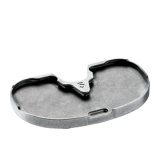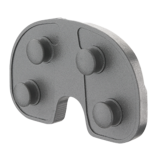Product Description
The Zimmer NexGen Precoat Pegged Tibial Plate supports Zimmer’s vision in MIS products and surgical techniques. With its proven clinical history in the Zimmer M/G® and MG II® Total Knee Systems, the NexGen Precoat Pegged Tibial Plate is MISprocedure friendly and addresses many issues relating to surgical procedure, implantation, and future revision TKA.
- Low-profile design simplifies insertion into the small incision/opening required for the Zimmer MIS Quad-Sparing™Total Knee Procedure
- Superior stability with minimal bone removal1,2
- 20 years of excellent clinical results3
The Zimmer NexGen Precoat Pegged Tibial Plate is proven to have excellent long-term clinical results.1 The clinical performance of the NexGen Knee has been followed for 7 years in a prospective, open, multi-center outcomes study consisting of 11,257 patients and 13,250 cases collected by 243 surgeons throughout the United States. Annual radiographic follow-up to 5 years shows the incidence of radiolucency to be very infrequent for pegged tibial plates.
The Zimmer NexGen Precoat Pegged Tibial Plate does not invade/pressurize the tibial IM canal, minimizing the potential for fat emboli. Its tibial preparation approach conserves more bone versus traditional stemmed tibial plates, preserving bone stock if/when revision TKA is needed.
Product Brochure
Indications
- Rheumatoid arthritis, osteoarthritis, traumatic arthritis, polyarthritis
- Collagen disorders, and/or avascular necrosis of the femoral condyle
- Post-traumatic loss of joint configuration, particularly when there is patellofemoral erosion, dysfunction or prior patellectomy
- Moderate valgus, varus, or flexion deformities
Individualization of Treatment
Contraindications
- Previous history of infection in the affected joint and/or local/systemic infection that may affect the prosthetic joint
- Insufficient bone stock on the tibial surface
- Skeletal immaturity
- Neuropathic arthropathy
- Osteoporosis or any loss of musculature or neuromuscular disease that compromises the affected limb
- A stable, painless arthrodesis in a satisfactory functional position
- Severe instability secondary to the absence of collateral ligament integrity









